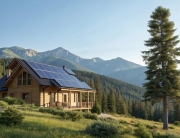Log home insurance is a necessity to pay for losses related to your home and property. Where would you be without it if your home was destroyed or someone was injured on your property and wants to sue? You would suffer financially and mentally if you had to replace your home at today’s prices. These are reasons you need adequate homeowner’s insurance.
Your agent will present options that cover hazards in different amounts in your circumstances and premiums that vary accordingly. In summary, key coverages typically include Dwelling, Other Structures, Personal Property, Loss of Use, and Liability/Medical Payments. The key to log home insurance is having adequate coverage to meet your needs, especially replacement of your home if it is destroyed.
Homeowners Insurance: Log Siding Home Versus Full Log Home
Insuring a log siding home or cabin is different from insuring a full log home, and you should note a comparison between the two. Pine log siding is real wood siding and is secured to conventional wall framing, unlike full logs that are stacked on top of each other to make walls. The advantages of pine log siding over full logs include:
- Homeowner’s insurance is less expensive for log siding homes.
- Pine log siding is less expensive for materials, labor, and transportation.
- It is faster and easier to install with less measuring, sawing, and fitting.
- Homeowners with woodworking knowledge and skills can install log siding.
- It’s easier and faster to find a building contractor compared to full logs.
- Pine log siding is readily available year-round and can be shipped to your home.
Log Home Insurance: Dwelling Coverage
Homeowner’s insurance covers many hazards and perils, so let’s start with dwelling coverage. Dwelling coverage pays to repair or rebuild the physical structure of your home if it’s damaged by a covered peril, such as fire, wind, or hail. Coverage needs to be enough to rebuild your home at current prices. Consider policies with extended or guaranteed replacement cost, which can cover costs that exceed your policy limit if construction prices rise.
“Key coverages typically include Dwelling, Other Structures, Personal Property, Loss of Use, and Liability/Medical Payments.”
Other Structures Coverage
 Other structures coverage pays for detached structures on your property, such as a garage, tool shed, tree house, swimming pool, pergola, or fence, usually for a percentage of your dwelling coverage amount, typically 10% of the home’s insurance amount.
Other structures coverage pays for detached structures on your property, such as a garage, tool shed, tree house, swimming pool, pergola, or fence, usually for a percentage of your dwelling coverage amount, typically 10% of the home’s insurance amount.
Personal Property Coverage
Personal property coverage covers the full value of your personal belongings, such as furniture, clothing, and electronics, if they are damaged, stolen, or destroyed. Some policies cover the depreciated value first, and then pay the difference after you buy replacements or make repairs and provide receipts. Talk to your agent about the difference in these two coverages. If you have valuable collections of items, itemized them and take photos for your agent.
Loss Of Use Of Home
Loss of use coverage covers additional living expenses, such as hotel stays, food, and restaurant bills, if a covered loss makes your home uninhabitable. It covers living elsewhere for a specified period or a total dollar limit.
Personal Liability and Medical Payments
Two other features of standard homeowner’s insurance are personal liability and medical payments. Personal liability protects you from lawsuits if someone is injured in your home or if you unintentionally cause injury to others off your property.
The medical payments section covers medical bills for guests who are accidentally injured on your property, regardless of who is at fault.
Log Home Insurance: Other Optional Coverages
Homeowner’s insurance plans provide optional coverages (add-ons) at additional cost to meet your individual circumstances and additional needs, including:
- Water Backup and Sump Pump Overflow: Protects against damage from a sewer, drain backup, or a sump pump failure.
- Earthquake Protection: Standard policies do not cover earthquake damage, so you need to purchase this as a separate endorsement or policy.
- Flood Insurance: This is a separate policy from standard policies and is necessary to cover damage from flooding. Floor insurance may or may not be available in your area.
- Building Code Upgrade: This endorsement can help pay for increased costs to rebuild your home to meet current building codes following a home’s loss.
- Scheduled personal property: Increases coverage limits for high-value items like jewelry, art, or firearms that have low standard limits.
- Replacement cost: Ordinance or law coverage pays the cost of rebuilding your home to meet current building codes. Extended or guaranteed replacement cost provides additional funds above your dwelling limit to cover the full cost of rebuilding your home if costs are higher than expected.
- Identity theft protection: Covers expenses and costs associated with restoring your identity if it’s stolen.
- Equipment breakdown: Covers the repair or replacement of home systems and appliances (like HVAC, water heaters, heat pumps) that break down due to mechanical or electrical issues.
- Home business insurance: Extends coverage to a home-based business, including its inventory and equipment.
- Service line coverage: Covers the repair of underground utility lines, such as water, gas, or electric, that run to your home.
- Umbrella insurance: Provides additional liability protection above your home and auto policies.
- Electronic data recovery: Covers the cost of recovering lost computer data.
In summary, the key to homeowner’s insurance is having adequate coverage to meet your needs, especially for replacing your home if it is destroyed. Thoroughly discuss your options with your insurance agent and shop around for the best companies and prices.







Recent Comments